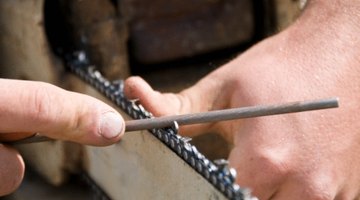Why Do Chainsaws Cut on a Curve?
A chainsaw’s chain cuts through wood by pulling it through the wood, much like an automatic can opener. This feeds wood continuously through the chain, making the chain cut straight through the wood.

A chainsaw’s chain cuts through wood by pulling it through the wood, much like an automatic can opener. This feeds wood continuously through the chain, making the chain cut straight through the wood. If the chain curves to the left or right, the chain isn’t slicing through the wood properly, which can pose a dangerous problem for the sawyer.
Teeth Different Sizes
A chain will cut to the left or the right when the cutting teeth on the chain are different lengths. One set of cutters faces to the right and the other set of cutters faces to the left. If one set of cutters is smaller than the other it will cause the chain to pull towards the longer cutters. This happens due to the way the teeth pull the wood through the chain. In felling operations this can be potentially fatal, as you may under-slice your back cut, leaving insufficient holding wood, causing the tree to break early.
Causes
Two main reasons will cause the chain to cut on a curve. The most common reason is from improper hand filing. If one side of the teeth is more heavily damaged, sharpening them down will make them smaller than the other side. This is why you should always count the number of file strokes, take off as little metal as possible and file the teeth regularly. Keeping the teeth uniform will prevent them from cutting on a curve. The other reason occurs when several teeth on one side have broken off entirely as in when the chain hit a rock, wire or other metal object.
Correcting the Teeth
Correcting improperly filed teeth may take a lot of time filing down the longer ones until they match the smallest cutter. Use a file guide to measure the length of the smallest cutter and file every tooth down to that size. To prevent this from recurring, always start the filing process with the smallest or most heavily damaged tooth. This will allow you to keep track of the length of the smallest tooth and file the others accordingly.
Replacing the Chain
Sometimes a poorly sharpened or damaged chain can’t be fixed. If the smallest cutters have gotten too small to file, replace the chain. If the teeth can’t be fixed or corrected through filing, replace the chain. Also, replace the chain whenever you notice teeth are missing from damage. This will cause the other teeth to work harder, which may result in the chain snapping and flying back into your legs. The cost of a new chain is far less than the cost of a hospital visit, so don’t take any chances with a bad chain.
References
Writer Bio
Currently based in Minneapolis, Minn., Eric Blankenburg has been a freelance journalist since 2000. His articles have appeared in "Outside Missoula, Outside Bozeman," "Hello Chengdu" and online at GoNomad.com and various other websites. He holds a Bachelor of Arts in creative writing from the University of Montana.
Photo Credits
- Jupiterimages/Photos.com/Getty Images
- Jupiterimages/Photos.com/Getty Images
More Articles



